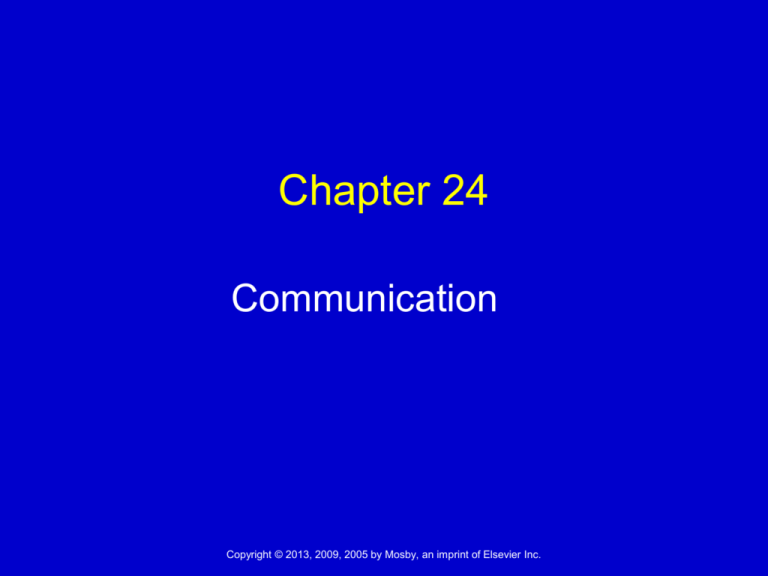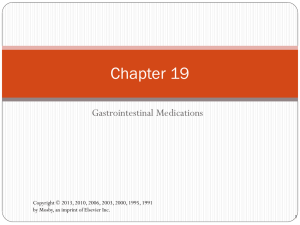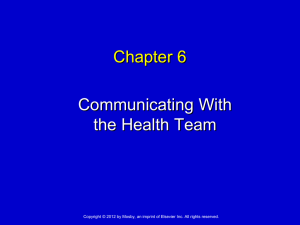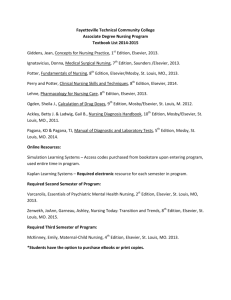Therapeutic communication techniques
advertisement

Chapter 24 Communication Copyright © 2013, 2009, 2005 by Mosby, an imprint of Elsevier Inc. Communication and Nursing Practice A lifelong learning process for nurses An essential attribute of professional nursing practice Builds relationships with patients, families, and multidisciplinary team members Copyright © 2013, 2009, 2005 by Mosby, an imprint of Elsevier Inc. 2 Communication and Interpersonal Relationships Communication is the means to establish helping-trust relationships. The ability to relate to others is important for interpersonal communication. Developing communication skills requires an understanding both of the communication process and of one’s own communication experience. Copyright © 2013, 2009, 2005 by Mosby, an imprint of Elsevier Inc. 3 Communication and Interpersonal Relationships (cont’d) Therapeutic communication occurs within a healing relationship between a nurse and a patient. The nurse’s communication can result in both harm and good. Skilled communication empowers others and enables people to know themselves and to make their own choices. Copyright © 2013, 2009, 2005 by Mosby, an imprint of Elsevier Inc. 4 Developing Communication Skills Critical thinking Perseverance and creativity Self-confidence Fairness and integrity Humility Copyright © 2013, 2009, 2005 by Mosby, an imprint of Elsevier Inc. 5 Developing Communication Skills (cont’d) Thinking is influenced by perception Five senses Culture Education Perceptual bias Copyright © 2013, 2009, 2005 by Mosby, an imprint of Elsevier Inc. 6 Quick Quiz! 1. Match the levels of communication. 1. Intrapersonal A. One-to-one interaction between two people 2. Interpersonal B. Occurs within an individual 3. Transpersonal C. Interaction with an audience 4. Small group D. Interaction within a person’s spiritual domain 5. Public E. Interactions with a small number of people Copyright © 2013, 2009, 2005 Copyright by Mosby, line. an imprint of Elsevier Inc. 7 Levels of Communication 1. Intrapersonal 2. Interpersonal 3. Transpersonal 4. Small group 5. Public B. Occurs within an individual A. One-to-one interaction between two people D. Interaction within a person’s spiritual domain E. Interactions with a small number of people C. Interaction with an audience Copyright © 2013, 2009, 2005 by Mosby, an imprint of Elsevier Inc. 8 Quick Quiz! 2. You are invited to attend the weekly unit patient care conference. The staff discusses patient care issues. This type of communication is A. Public. B. Intrapersonal. C. Transpersonal. D. Small group. Copyright © 2013, 2009, 2005 by Mosby, an imprint of Elsevier Inc. 9 Basic Elements of the Communication Process Copyright © 2013, 2009, 2005 by Mosby, an imprint of Elsevier Inc. 10 Quick Quiz! 3. Match the basic elements of communication. 1. Referent A. One who encodes and one who decodes the message 2. Sender and receiver B. The setting for senderreceiver interactions 3. Message C. Message the receiver returns 4. Channels D. Motivates one to communicate with another 5. Feedback E. Means of conveying and receiving messages 6. Interpersonal variables F. Factors that influence communication 7. Environment G. Content of the message Copyright © 2013, 2009, 2005 by Mosby, an imprint of Elsevier Inc. 11 Basic Elements of the Communication Process D. Motivates one to communicate with another 1. Referent 2. Sender and receiver A. One who encodes and one who decodes the message 3. Message G. Content of the message 4. Channels E. Means of conveying and receiving messages 5. Feedback C. Message the receiver returns 6. Interpersonal variables F. Factors that influence communication 7. Environment B. The setting for sender-receiver interactions Copyright © 2013, 2009, 2005 by Mosby, an imprint of Elsevier Inc. 12 Forms of Communication Verbal aspects of communication: Vocabulary Intonation Pacing Denotative Clarity and and brevity connotative meaning Timing and relevance Copyright © 2013, 2009, 2005 by Mosby, an imprint of Elsevier Inc. 13 Forms of Communication (cont’d) Nonverbal Personal appearance Posture and gait Facial expressions Eye contact Gestures Sounds Territoriality and personal space Copyright © 2013, 2009, 2005 by Mosby, an imprint of Elsevier Inc. 14 Forms of Communication (cont’d) Symbolic The verbal and nonverbal symbolism used by others to convey meaning Metacommunication A broad term that refers to all factors that influence communication Copyright © 2013, 2009, 2005 by Mosby, an imprint of Elsevier Inc. 15 Nurse-Patient Relationship 1. Preinteraction phase: occurs before meeting the patient 2. Orientation phase: when the nurse and the patient meet and get to know each other 3. Working phase: when the nurse and the patient work together to solve problems and accomplish goals 4. Termination phase: occurs at the end of a relationship Copyright © 2013, 2009, 2005 by Mosby, an imprint of Elsevier Inc. 16 Professional Nursing Relationships Nurse-patient helping relationships Nurse-family relationships Nurse-health team relationships Nurse-community relationships Copyright © 2013, 2009, 2005 by Mosby, an imprint of Elsevier Inc. 17 Case Study Roberto Ruiz is a 44-yearold man of Puerto Rican descent, suffering from HIV/AIDS. He was near death and in hospice, but his condition has improved and he is now home. Suzanne is a 54-year-old nurse dedicated to hospice and committed to maximizing quality of life in end-of-life care. Copyright © 2013, 2009, 2005 by Mosby, an imprint of Elsevier Inc. 18 Quick Quiz! 4. Helping relationships serve as the foundation of clinical nursing practice. Contracts for a therapeutic helping relationship are formed during the A. Orientation stage. B. Working stage. C. Termination stage. D. Preinteraction stage. Copyright © 2013, 2009, 2005 by Mosby, an imprint of Elsevier Inc. 19 Elements of Professional Communication Appearance, demeanor, and behavior Courtesy Use of names Trustworthiness Autonomy and responsibility Assertiveness Copyright © 2013, 2009, 2005 by Mosby, an imprint of Elsevier Inc. 20 Case Study (cont’d) As Suzanne works with Roberto, she develops a helping relationship. Suzanne knows that posing questions for the patient’s reflection helps her assess his needs and support his self-care strategies. Copyright © 2013, 2009, 2005 by Mosby, an imprint of Elsevier Inc. 21 Nursing Process: Assessment Through the patient’s eyes Gather information, synthesize, apply critical thinking Physical and emotional factors Developmental factors Sociocultural factors Gender Copyright © 2013, 2009, 2005 by Mosby, an imprint of Elsevier Inc. 22 Case Study (cont’d) Suzanne learns that Roberto wants to travel to New York to see his extended family. Even though Roberto is in poor health and the trip will be difficult, Suzanne expresses her understanding of the importance of the trip. She understands how important extended family is in the Puerto Rican culture. Copyright © 2013, 2009, 2005 by Mosby, an imprint of Elsevier Inc. 23 Nursing Process: Diagnosis Nursing diagnosis for communication Many patients experience difficulty with communication: • Lacking skills in attending, listening, responding, or selfexpression • Inability to articulate, inappropriate verbalization • Difficulty forming words • Difficulty with comprehension Copyright © 2013, 2009, 2005 by Mosby, an imprint of Elsevier Inc. 24 Nursing Process: Planning Goals and outcomes Specific and measurable Setting of priorities Teamwork and collaboration Copyright © 2013, 2009, 2005 by Mosby, an imprint of Elsevier Inc. 25 Case Study (cont’d) During her visit, Roberto tells Suzanne, “I really want to go visit my uncles in New York, but I’m not sure I’m up for the trip.” Suzanne is understanding: “It sounds like you miss your family. Let’s talk about your options for maintaining contact.” As they talk, Suzanne helps Roberto to identify two methods of communicating with his family in New York. Copyright © 2013, 2009, 2005 by Mosby, an imprint of Elsevier Inc. 26 Nursing Process: Implementation Therapeutic communication techniques are specific responses that encourage the expression of feelings and ideas and convey acceptance and respect. Active listening means being attentive to what a patient is saying both verbally and nonverbally. Use “SOLER”: Sit facing the patient; observe an open posture, lean toward the patient, establish and maintain intermittent eye contact; relax Copyright © 2013, 2009, 2005 by Mosby, an imprint of Elsevier Inc. 27 Nursing Process: Implementation (cont’d) Therapeutic communication techniques Nontherapeutic communication techniques Adapting communication techniques Copyright © 2013, 2009, 2005 by Mosby, an imprint of Elsevier Inc. 28 Adapting Communication Techniques Patients who cannot speak clearly Cognitive impairment Hearing impairment Visual impairment Unresponsive Patients who do not speak English (or your language) Copyright © 2013, 2009, 2005 by Mosby, an imprint of Elsevier Inc. 29 Quick Quiz! 5. While admitting a patient, during the initial interview, a family member tells you, “My mom really means that she does not understand her medical diagnosis.” The communication form used by the family member is A. Focusing. B. Clarifying. C. Summarizing. D. Paraphrasing. Copyright © 2013, 2009, 2005 by Mosby, an imprint of Elsevier Inc. 30 Nursing Process: Evaluation Through the patient’s eyes Patient outcomes Nurses and patients need to determine whether the plan of care has been successful. Nursing interventions are evaluated to determine which strategies or interventions were effective. If expected outcomes are not met, the plan of care needs to be modified. Copyright © 2013, 2009, 2005 by Mosby, an imprint of Elsevier Inc. 31





